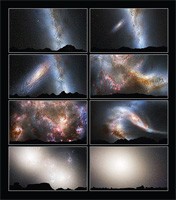Cosmic Collisions

By Robert Marshall
It has been almost 100 years since Edwin Hubble measured the universe beyond the Milky Way.
Today, astronomers believe that as many as 100 billion other galaxies may be sharing the cosmos.
Classified by shape, most of these cosmic islands are either spiral or elliptical, but star-gazing scientists have discovered galaxies that don't quite fit these molds. Common to the "irregular" category are galaxies which interact with other galaxies. These gravitational interactions are often referred to as mergers and their existence invites the question: Is the Milky Way collision-prone?
If the answer is yes, could a collision happen in our lifetime? What would happen to our sun? To Earth? To evaluate the probability, look no further than the most distant object the human eye can detect — to the Andromeda Galaxy (M31), located more than 2.5 million light-years away. It appears as a small fuzzy patch in the sky but there is nothing miniature about Andromeda. Similar to the shape (spiral), size and mass of the Milky Way, M31 is home to a trillion other suns.
Astronomers have known for decades that our galactic neighbor is on the move and closing in fast — at approximately 250,000 miles per hour. Andromeda's blueshift — a decrease in electromagnetic wavelength caused by the motion of a light-emitting source (star) as it moves closer to the observer — is by no means breaking news. However, data recently collected from the Hubble Space Telescope predicts a merger with certainty, in an estimated four billion years. Our sun will still be shining. Whether humans still inhabit the planet is unknown, but Earth will most likely survive the impact. Galaxies, although single units of stars gravitationally tied together, are mostly gigantic voids. One can think of a galaxy-on-galaxy collision as similar to the pouring of one glass of water into another. he end result is a larger pool of water, or in the case of a collision: stars.
Classroom Discussion
- Look at a number of photographs of different galaxies. How would you classify them? Now look up "Hubble's Tuning Fork" and evaluate how your results differ. Why?
- Where in the sky is Andromeda located? Is it more visible at a particular time of year?
